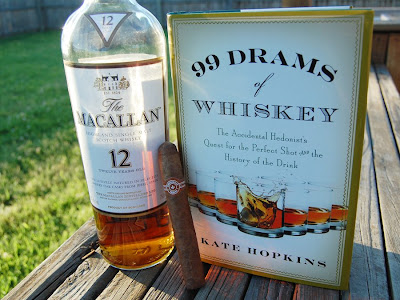I'm talking about 99 Drams of Whiskey: The Accidental Hedonist's Quest for the Perfect Shot and the History of the Drink by Kate Hopkins, known to the blogosphere as The Accidental Hedonist. Kate and her trusty sidekick Krysta toured the distilleries and sampled the whiskeys and whiskys of Ireland, Scotland, Canada, Pennsylvania, and had the dignity and clarity of mind to conclude their journey with the Commonwealth of Kentucky and the Great State of Tennessee.
In addition to tasting notes in each chapter, this is a frequently hilarious story about researching a great topic, and in the great tradition of travel literature, the best parts are when things don't go quite right. Troubles with the GPS, being surrounded by tourists, difficulties with the increasingly surreal airline industry... I've been there. Kate pulls no punches, and tells the truth no matter how grisly.
 Someone once asked
Someone once asked The cigar was a Montecristo No. 4 from... well, I don't know precisely where it came from. Just in case it wasn't entirely legal, I did my patriotic duty and destroyed it. By burning. Slowly, over the course of an hour. The Scotch is leftover from our Burns Night celebration, a gift from my father who really knows his whisky. This is The Macallan 12 year old, aged in Sherry oak casks from Spain. Nice and dark, rich flavors with a hint of spice and vanilla, and an aroma that will last for days. And while savoring this perfect late afternoon, I listened to The Unauthorized Biography of Reinhold Messner by Ben Folds Five.
Having all of these elements in place is not required when reading this book, but if you have even the slightest love for the dark liquors, you will get mighty thirsty while turning pages. Ideally you'd want to match your whiskey consumption to the geographical chapter of the book, but I found that even a glass of wine worked well in a pinch.
* * *
Kids, back in the early days, The Daily Show was hosted by Craig Kilborn. He wasn't the strongest interviewer in the world, so the writers developed the concept of "The Five Questions", trivial or goofy queries that he could posit to celebrities. In this spirit, I always try to ask questions that go off the usual script, something that hasn't already been asked a million times or addressed in the source material. Kate was kind enough to respond:
#1: Which musician or musical group would you recommend listening to while reading this book?
"As for Music, Dropkick Murphy and Flogging Molly are what we had on our iPods as we traveled, but I would also suggest a bit o' Frank Sinatra."
#2: Have you found a perfect dessert pairing with a good Scotch?
"A great pairing with Scotch Whisky is dried ginger believe it or not. Chocolate bars can also work well, but I'd avoid pastries or anything with cream."
#3: Which city provided the most unintelligible dialect of English for American ears?
"Glasgow, by far. But it still wasn't as bad as many people would have you believe."
#4: Irish coffee: real whipped cream or the fake stuff from a can?
"Irish Coffee is a waste of good whiskey. But, if you must have some, forego the whipped cream all together."
#5: What's your favorite type of glass for serving whiskey?
"A clean one ;-) In all honesty, I like a smooth Scotch glass, as I like adding an ice cube or two to my whiskey."
* * *
With Father's Day approaching, this would be an outstanding gift if your Dad is a guy who appreciates a good whiskey. Or if you're a novice to the whole scene, this will save you thousands of dollars in travel, allowing you to pinpoint your favorite spots in the future. At just over 300 pages, this is not a textbook, not an encyclopedia... it's an entertaining read for anyone who appreciates a good travelogue.

































